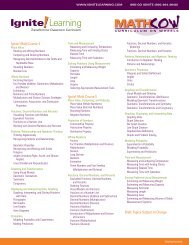The Silent Epidemic: Perspectives of High School ... - Ignite! Learning
The Silent Epidemic: Perspectives of High School ... - Ignite! Learning
The Silent Epidemic: Perspectives of High School ... - Ignite! Learning
Create successful ePaper yourself
Turn your PDF publications into a flip-book with our unique Google optimized e-Paper software.
Notes<br />
success, and characteristics related to school culture and structure. He also mentions some <strong>of</strong> the difficulties with<br />
such programs, such as attracting students and school resources to support such programs.<br />
41 Kerr & Legters, 238.<br />
42 <strong>The</strong> numbers <strong>of</strong> students who are truant from school is <strong>of</strong>ten daunting. In Colorado, for example, it is estimated that<br />
every day 70,000 students are truant from school and in Philadelphia alone there are an average <strong>of</strong> 20,000 students<br />
truant per day. Truancy is just one area where increased parent involvement can be vitally important and productive.<br />
After all, schools can hardly do their job if the child is not in their building. See Harmacek, Marilyn ed. (2002) Youth<br />
Out <strong>of</strong> <strong>School</strong>: Linking Absences to Delinquency. 2nd edition. Colorado: <strong>The</strong> Colorado Foundation for Families and<br />
Children, 2-3; and Street, John F (2001) Interview by Rocky Mountain Public Television, Corporation for Public<br />
Broadcasting.<br />
43 Eagle, E. (1994). Socioeconomic Status, Family Structure, and Parental Involvement: <strong>The</strong> Correlates <strong>of</strong> Achievement in<br />
A New Generation <strong>of</strong> Evidence: <strong>The</strong> Family is Critical to Student Achievement. Edited by Henderson & Berla. Washington,<br />
DC: Center for Law and Education, 59-60; Henderson, A. T. & N. Berla, eds. (1994) A New Generation <strong>of</strong> Evidence: <strong>The</strong><br />
Family is Critical to Student Achievement. Washington, DC: Center for Law and Education; U.S. Department <strong>of</strong> Education<br />
(1994). Strong Families, Strong <strong>School</strong>s: Building Community Partnerships for <strong>Learning</strong>. U.S. Department <strong>of</strong> Education;<br />
Ziegler, S. (1994). <strong>The</strong> Effects <strong>of</strong> Parent Involvement on Children’s Achievement: <strong>The</strong> Significance <strong>of</strong> Home <strong>School</strong> Links<br />
in A New Generation <strong>of</strong> Evidence: <strong>The</strong> Family is Critical to Student Achievement. Edited by A.T. Henderson & N. Berla.<br />
Washington, DC: Center for Law and Education, 151 – 152. We note that an October 2005 study from Education Trust<br />
found that parent involvement ranks fifth on the list <strong>of</strong> factors that help improve California students’ test scores in<br />
lower income, minority schools. Elements that ranked ahead <strong>of</strong> that were: linking lessons to state academic standards;<br />
ensuring that there are enough textbooks and other teaching materials; regular, careful analysis <strong>of</strong> student<br />
performance; and placing a high priority on student achievement. <strong>The</strong> good news from this study is that it supports<br />
the notion that students can still do well in spite <strong>of</strong> poverty and other challenges. Wherever parent involvement ranks<br />
on the helpfulness scale, it remains one way to help increase graduation rates, but it is not the only way. It will take a<br />
multitude <strong>of</strong> approaches to address this problem successfully.<br />
44 Carnegie Council on Adolescent Development (1989). Turning Points: Preparing American Youth For the 21st Century.<br />
New York: <strong>The</strong> Carnegie Corporation.<br />
45 National Middle <strong>School</strong> Association Research Committee (2003). An Adult Advocate For Every Student in This We<br />
Believe: Successful <strong>School</strong>s For Young Adolescents. Westerville, OH: National Middle <strong>School</strong> Association: 16-17.<br />
46 Alliance for Excellent Education (2004). Alliance for Excellent Education Commends NASSP Report, Breaking Ranks II,<br />
for Its Hands on Approach. Washington, DC: Alliance for Excellent Education.<br />
47 We note that there are some studies that provide support for raising maximum compulsory school age requirements.<br />
Angrist & Kruger (1991). Does Compulsory <strong>School</strong> Attendance Affect <strong>School</strong>ing and Earnings? Quarterly Journal<br />
<strong>of</strong> Economics: 979-1014 (in which they suggest that roughly 25 percent <strong>of</strong> potential dropouts remain in school<br />
because <strong>of</strong> such laws); see also Bhanpuri & Reynolds (2003). Understanding and Addressing the Issue <strong>of</strong> the <strong>High</strong><br />
<strong>School</strong> Dropout Age. Illinois: <strong>Learning</strong> Point Associates, 1 (in which they note that numerous states have recently<br />
increased their maximum compulsory school attendance age).<br />
48 Conant, James B. (1961). Slums and Suburbs: A Commentary on <strong>School</strong>s in Metropolitan Areas. New York:<br />
McGraw Hill.<br />
49 Orfield, 5; see also Greene & Winters (2005), 5. One recommended method compares the number <strong>of</strong> graduates<br />
28








